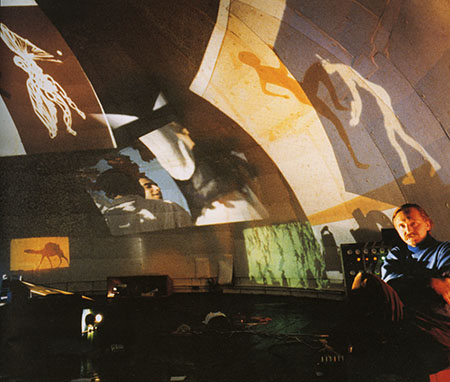Ghosts in the Machine

There was perhaps no better way to prepare yourself for the New Museum’s excellent survey of art and technology, ‘Ghosts in the Machine’, than to first enter the accompanying exhibition, ‘Pictures from the Moon: Artists’ Holograms 1969–2008’. Here, in a darkened room, could be found examples of what was once deemed the medium of the future – the hologram. Hovering on the walls, exuding their unmistakable fuzzy green and red hues, the holograms seemed both modern and antiquated, much like the space age itself.
In Bruce Nauman’s Hologram H (1969), the artist attempted to contort his whole body into the holographic field. But the result seemed less kinetic than cadaverous, like a drowned figure suspended in the deep. Chuck Close’s self-portrait Untitled #1 (1997/2005) hung eerily in the air like a decapitated head without a spike, and you could almost hear the echoes emanating from Louise Bourgeois’ creepy dioramas of tiny furniture. There was a sumptuous lifelessness to the holograms that is explored most fully by Ed Ruscha’s The End #2 (1998/2007) that shows the words ‘The End’, written in an archaic typeface, set against a scratched celluloid background and radiating that sickly outdated glow. Obsolete technologies were piled one on top of the other. It felt like the right way to begin.
It was something of a surprise to enter the first of the three galleries devoted to ‘Ghosts in the Machine‘ and find it populated with Op art. Yet it made immediate sense once you began to view picture after disorientating picture. These art works, seemingly simple when viewed alone, grew ever more complex the more of them one saw; as with the holograms, the simple movement of the viewer revealed massive, destabilizing complexity. As exhibition curators Massimiliano Gioni and Gary Carrion-Murayari suggested, Op ‘internalized technology’ and one’s visual sense felt like it was being stripped bare, broken down into a binary of black and white, ready to be rebooted.
In the midst of these floated Hans Haacke’s Blue Sail (1964–5), a large piece of blue chiffon that is precision-balanced to waft and drift over an oscillating fan. The piece’s simple beauty is startling if one knows Haacke mainly for his coruscating political pieces that identify systemic links between museum trustees and big business. Yet here was a distinct (if polemic-free) predecessor, similarly detailing the balanced interaction between differing components and their environment, a feedback loop notof money but of gentle physical forces.
Sensuousness was surprisingly present in a show built around technology. Konrad Klapheck’s anthropomorphic paintings of mechanical appliances – a cash register, a faucet – showed him to be a sort of Pygmalion, able to imbue the humblest machine with organic life. This inclination was evident even in the work of Georg Nees and the New Tendencies digital art movement that began in Zagreb in the 1960s. Their computer-made art seemed as ornate as fine lace, their designs as involving as those on Persian carpets. These pieces, as well as Herb Schneider’s engineer drawings of lighting and sound rigs, seemed to be reaching towards Emma Kunz’s mandala-like New Age drawings (and vice versa) with both keen to explore the hallucinogenic chaos at the heart of mechanical repetition.
This was where things started to turn threatening. The show never reached for an easy technological dystopia but instead hinted at our technological uneasiness, at machines being more than machines, and humans being less than human. Take the selection from Larry Sultan and Mike Mandel’s Evidence (1977), a collection of terrifying snapshots of strange quasi-technical experiments culled from government archives. Or the art of schizophrenic visionaries such as Jakob Mohr, whose drawings of mysterious machines controlling him seemed oddly well versed in technological jargon and images. The more one became immersed in this show with its accumulation of charts, wires, threads and cords, the more one seemed to be viewing a sort of Gray’s Anatomy (1858) of our technological world. An autopsy was taking place but you were never certain whether you would find blood or electricity beneath the skin. Perhaps the most entrancing and frightening piece, for this reviewer, was Seth Price’s Film/Right (2006), a six-second-long digital clip of plunging ocean waves that is looped and graphically manipulated so that the effect is both ever-changing and endlessly the same.
Any show which can move the viewer from watching a film of J.G. Ballard driving down his fateful motorways straight into a collection of Rube Goldberg cartoons is nothing short of inspired, for there is something comic in Ballard’s dystopian dreams, just as there is something nightmarish in Goldberg’s madcap inventions. As it was, one of the most though-provoking pieces was left until last: the installation of Stan VanDerBeek’s Movie-Drome (1963–6), an immersive cinematic environment that bathes the viewer in a constant stream of moving images. To its original audience it must have seemed overwhelming, like the famed brainwashing scene in the film The Ipcress File (1965), but to a present-day visitor lying on the floor looking up at the changing images on the roof, it seemed soothing, almost ambient. Uh-oh.

















